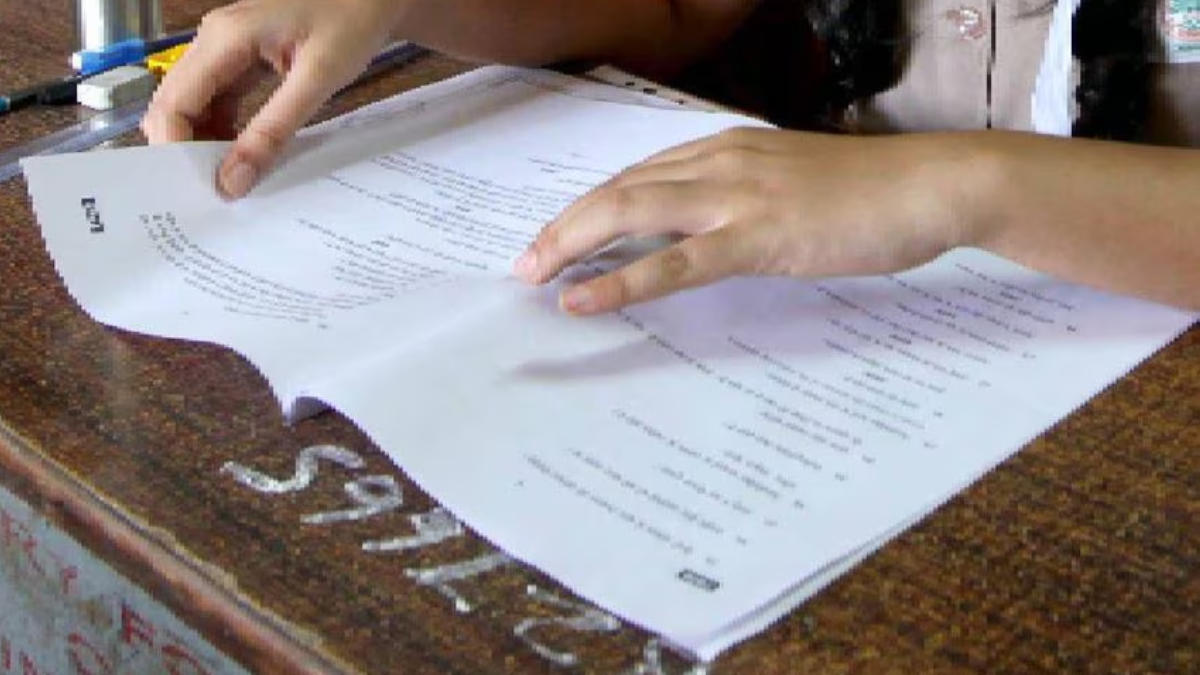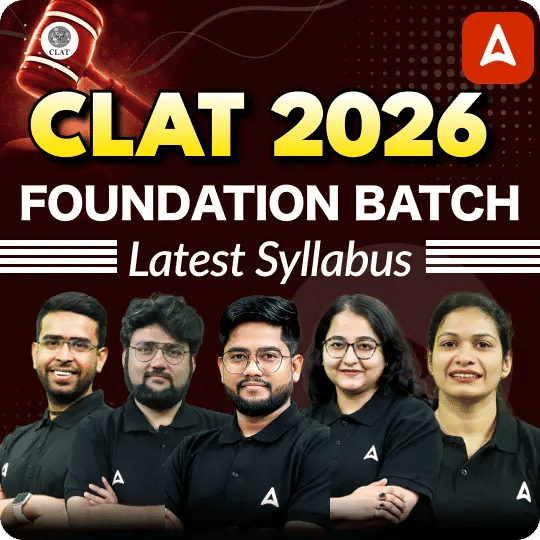Table of Contents
The Consortium of National Law Universities (NLUs) is scheduled to conduct the Common Law Admission Test (CLAT) on Sunday, December 1, 2024. This year the exam will start at 02: 00 P.M and conclude at 04:00 P.M. As the exam approaches, this is the most crucial time for practicing model question papers which helps students grasp the concepts more effectively. Adda247Law Experts has preparations for CLAT Expected Question Paper 2025, considering the latest paper pattern and the previous year’s question trends. Students who are preparing for the law entrance test must refer the CLAT 2025 Expected Question Paper with Solutions given on this page.
CLAT Expected Question Paper 2025
The CLAT Ecperted question paper 2025 which is shared on this page, is completed based on the latest paper pattern and syllabus. Regarding the latest CLAT 2025 syllabus and test structure, The CLAT syllabus consisted of five components: English Language, Legal Reasoning, Current Affairs, Logical Reasoning, and Quantitative Techniques. There will be 120 MCQ questions that must be completed by the students in the two-hour duration. Each multiple-choice question in the CLAT UG exam is worth one mark, and incorrect responses cost 0.25 marks. By practicing the CLAT Expected Question Paper 2025, students can identify the strengths areas, as well as the weak areas where they need improvement.
CLAT 2025 Expected Question Paper with Solutions PDF Download
We at Adda247 share your most expected CLAT Question paper that allows students to familiarize themselves with the real exam environment, exam structure, the number of questions and their types, and marking scheme. This paper was created by our in-house experienced subject experts after conducting CLAT’s previous year’s question paper. Download the CLAT 2025 Expected Question Paper with solutions by clicking the link shared below.
Most Expected CLAT Question Paper 2025 with Solutions
Direction (1-5) Read the following passage carefully and answer the questions given below.
English literature in India has a rich and multifaceted history, shaped by the confluence of colonial influences and the inherent diversity of Indian culture. The advent of English as a medium of instruction during British rule catalyzed the creation of a unique body of work that seamlessly blends Western literary forms with Indian sensibilities. The early writers, such as Raja Rao, R.K. Narayan, and Mulk Raj Anand, carved a niche by portraying rural landscapes, everyday struggles, and the dichotomy of tradition and modernity. Their narratives reflected the socio-political dynamics of a nation on the brink of independence.
Post-independence, the literary focus shifted towards exploring identity, displacement, and globalization. Writers like Salman Rushdie, Anita Desai, and Arundhati Roy brought Indian literature to global prominence. Rushdie’s “Midnight’s
Children” is a testament to the complex intertwining of personal and national histories, while Roy’s “The God of Small Things” critiques societal structures with lyrical prose.
Modern Indian English literature continues to evolve, embracing themes of technology, gender, and environmental challenges. Writers such as Aravind Adiga and Jhumpa Lahiri delve into the intricacies of urbanization, diaspora, and cultural hybridity. Meanwhile, regional literature in translation has further enriched this spectrum, ensuring that the unique voices of diverse Indian languages find their place in the global literary discourse. The symbiosis of traditional and contemporary themes has ensured that Indian English literature remains vibrant, reflective, and relevant.
Q1. What can be inferred about the impact of British colonialism on the evolution of Indian English literature?
(a) It entirely erased native literary traditions.
(b) It introduced Indian writers to global literary themes.
(c) It limited the scope of Indian storytelling.
(d) It forced writers to adopt Western styles without innovation.
Ans. (b)
Sol. The passage highlights how British colonialism introduced Indian writers to global literary themes while allowing them to blend these with their own cultural narratives.
Q2. Based on the passage, how has the theme of identity evolved in Indian English literature post-independence?
(a) It focuses exclusively on urbanization.
(b) It reflects a synthesis of personal and collective histories.
(c) It dismisses traditional narratives.
(d) It is constrained by Western influences.
Ans. (b)
Sol. Post-independence, Indian English literature reflects a synthesis of personal and national histories, as seen in works like “Midnight Children”
Q3. Which of the following best describes the contribution of regional literature in translation to Indian English literature?
(a) It dilutes the authenticity of Indian culture.
(b) It provides diversity and broader representation.
(c) It focuses only on ancient Indian traditions.
(d) It marginalizes English as a medium of expression.
Ans. (b)
Sol. The passage mentions that regional literature in translation enriches Indian English literature by ensuring broader representation of India’s linguistic diversity.
Q4. What can be deduced about the role of modern writers like Aravind Adiga and Jhumpa Lahiri in Indian English literature?
(a) They disregard traditional themes.
(b) They emphasize technological narratives alone.
(c) They address the complexities of globalization and cultural hybridity.
(d) They primarily critique colonial legacies.
Ans. (c)
Sol. Modern writers explore globalization, urbanization, and cultural hybridity, as reflected in the works of Aravind Adiga and Jhumpa Lahiri.
Q5. How does the passage characterize the trajectory of Indian English literature over the decades?
(a) A shift from simplicity to over-complexity.
(b) A decline in originality due to globalization.
(c) A dynamic interplay of tradition and modernity.
(d) An irreversible Westernization of Indian themes.
Ans. (c)
Sol. The passage emphasizes the continuous evolution of Indian English literature through a dynamic interplay of tradition and modernity
Direction (6-10) Read the following passage carefully and answer the questions given below.
Hindi literature has a rich and varied history that mirrors the cultural, social, and political changes in India over the centuries. Originating from the 10th century with works like “Apabhramsha” poetry, Hindi literature gradually evolved, reaching its peak during the Bhakti and Riti periods. The Bhakti period, dominated by saint poets like Kabir, Tulsidas, and Mirabai, emphasized devotional themes and the universal love of God. Tulsidas’ “Ramcharitmanas” remains a cornerstone of Hindi literature, blending spirituality with linguistic finesse.
The Riti period, marked by poets such as Bihari Lal and Keshavdas, celebrated romantic and aesthetic themes, often rooted in classical Sanskrit traditions. With the advent of colonial rule in the 19th century, Hindi literature underwent a transformation. Writers like Bharatendu Harishchandra championed modern Hindi prose and poetry, addressing issues like education, women’s rights, and social reforms. This period also witnessed the rise of realism, with Munshi Premchand at
the forefront. His works, such as “Godan” and “Nirmala,” explored rural life, caste discrimination, and the plight of the marginalized.
Post-independence, Hindi literature expanded further, with writers like Nirmal Verma and Krishna Sobti exploring existentialism, identity, and contemporary social issues. Today, Hindi literature faces challenges from globalization, but its essence remains vibrant, finding new expressions in digital media and regional storytelling. It continues to be a powerful medium reflecting India’s diverse heritage and evolving ethos.
Q6. Which phase of Hindi literature can be associated with the emergence of devotional and spiritual themes, and what does it suggest about the socio-political climate of the era?
(a) Bhakti period, reflecting harmony and religious awakening
(b) Riti period, indicating the influence of Sanskrit aesthetics
(c) Colonial period, marked by educational reforms
(d) Post-independence period, highlighting existential dilemmas
Ans. (a)
Sol. The Bhakti period is associated with devotional themes, reflecting the harmony and religious awakening of the era.
Q7. How does the transition from the Riti period to the colonial period highlight the evolution of Hindi literature in addressing societal concerns?
(a) By focusing solely on romantic themes
(b) By shifting to realism and addressing social reforms
(c) By promoting only devotional literature
(d) By disregarding classical influences
Ans. (b)
Sol. The transition to the colonial period brought realism into Hindi literature, focusing on societal concerns like education and caste discrimination
Q8. What does the mention of modern Hindi writers like Nirmal Verma and Krishna Sobti reveal about the progression of Hindi literature in post-independence India?
(a) The decline of Hindi literature in urban settings
(b) The incorporation of existential and identity-related themes
(c) The resurgence of devotional poetry
(d) The dominance of regional languages over Hindi
Ans. (b)
Sol. Writers like Nirmal Verma and Krishna Sobti introduced existential and identity-related themes, marking a progression in literary expression post-independence
Q9. What challenge does Hindi literature face in the current era, as inferred from the passage?
(a) A lack of contemporary writers
(b) A decline in digital storytelling
(c) A struggle to preserve its essence amid globalization
(d) An inability to address rural issues
. Ans. (c)
Sol. The passage highlights globalization as a challenge, suggesting the struggle of Hindi literature to preserve its core essence while adapting to new media.
Q10. Based on the passage, how has Hindi literature managed to remain relevant despite the challenges posed by changing times?
(a) By focusing only on traditional themes
(b) By restricting itself to rural narratives
(c) By adapting to new media and addressing diverse issues
(d) By isolating itself from global influences
Ans. (c)
Sol. Hindi literature has remained relevant by evolving with digital media and addressing diverse issues, ensuring its contemporary appeal.




 Lawyer & Advocate Dress Code in Indi...
Lawyer & Advocate Dress Code in Indi...
 CLAT 2025 Cut Off, Check CLAT Passing Ma...
CLAT 2025 Cut Off, Check CLAT Passing Ma...
 CLAT Previous Year Question Papers, Down...
CLAT Previous Year Question Papers, Down...




